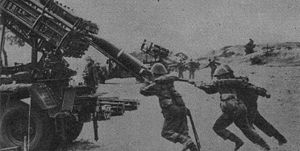BM-24


The BM-24 is a Soviet multiple missile launcher system .
development
The BM-24 was as a successor to the out of the Second World War coming BM-31-12 designed -Raketenwerfer (Katyusha). In the mid-1950s, the BM-24 was introduced to the Soviet land forces . From the 1960s, the system was also exported to the Warsaw signatory states. Further exports went to the Middle East and Africa. In the Soviet armed forces, the system was replaced by the BM-22 in the mid-1970s .
variants
- BM-24 : 1st series version with twelve turret tubes, mounted on a ZIS-151 truck.
- BM-24M : 2nd series version with twelve turret tubes, mounted on a ZIL-157 truck.
- BM-24T : Introduced in 1960, with twelve launchers, mounted on an AT-S tracked vehicle.
- Falak-1 SP : Version from Iran , with six launcher tubes, mounted on a jeep .
- Falak-1 MP : Version from Iran, single tube on a tripod.
technology
A tube package with twelve tubes of caliber 240.9 mm is mounted on the respective vehicle . A rocket launcher is able to fire all twelve rockets within ten seconds. As a rule, however, a volley is fired within 20 seconds. Reloading an empty turret takes around ten minutes. The vehicle crew consists of three soldiers, with a fourth soldier being called in to load the launcher in order to transport and load the 112.25 kg rockets using two loading tongs.
| Warhead | Type | Weight (kg) | of which explosives (kg) | Range (m) |
|---|---|---|---|---|
| M-24F | Splinterblast | 60.8 | 27.4 | 6,575 |
| M-24FUD | Splinterblast | 46.5 | 18.4 | 10,600 |
| MD-24F | Splinterblast | 48.4 | 18.2 | 17,500 |
| MS-24 | chemical ( AC , HD or GB ) | 12.0 | k. A. | 10,600 |
| MS-24US | chemical (AC, HD or GB) | 19.0 | k. A. | 16,000 |
| Falak-1 | Splinterblast | 50.0 | k. A. | 10,500 |
The missiles are spin stabilized and have no stabilizing wings . The swirl of the rocket is created by inclined nozzles arranged around the main drive nozzle. The maximum spread of a rocket volley is 93 to 118 m. Upon impact, the warhead created a crater 3 m in diameter and 2.4 m deep.
The rockets are ignited one after the other electrically with the 24-volt system of the base vehicle. Before firing, the vehicle must be secured against rolling away using wheel chocks. The driver's cab, which is also the battle station of the thrower operator and driver, is protected by foldable steel plates against flying stones, which inevitably occur when firing.
commitment
The BM-24 was first used by Egypt and Syria against Israel in the 1967 Six Day War. The Israeli forces captured several BM-24s. These were examined, modernized and integrated into the armed forces. In Israel even their own missiles were developed for the BM-24. Israel then used two BM-24 batteries in the 1973 Yom Kippur War and the 1982 Lebanon War .
Users
literature
- Kirill and Mefodiy: Encyclopedia of Armor . 1998.
- Jane's Information Group (Ed.): Jane's Armor and Artillery, Edition 1979–1980 .
- Andrew W. Hull, David R. Markov, Steven Zaloga : Soviet / Russian Armor and Artillery Design Practices: 1945 to Present . Darlington Productions, Darlington.

